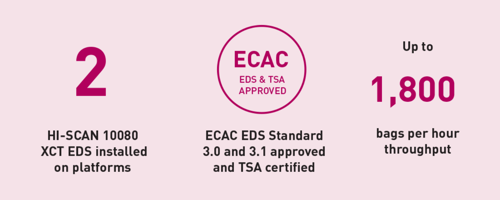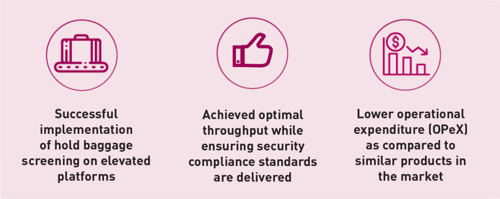For majority of airports, an efficient and reliable Hold Baggage Screening (HBS) System plays a paramount role in maintaining a high level of security and operational efficiency.
Air travel is on the rise, bringing about burgeoning numbers of baggage to screen. Airports must employ proper security solutions that enhance security control and are in compliance with new screening regulations. Additionally, shifting security threats that are getting more sophisticated with time means that airports must have a system that best helps mitigate new-generation risks.
All of this must be achieved without compromising the passenger experience.

A major airport in Hokkaido needed an advanced HBS system that enables it to perform detailed check baggage screening.
With numerous flight routes to serve and to manage the increasing baggage volume, a reliable HBS system that delivers a high throughput and detection performance was required—to improve operational efficiency whilst maintaining high security standards.
Additionally, at the existing airport infrastructure where the baggage handling system (BHS) was installed on the ground, it was impossible to have an HBS without taking up the space meant for the baggage handling and sorting operation.
Any space reconfiguration to where the BHS was installed at might result in bottlenecks where staff and luggage carts are unable to move around with ease.

To address the airport’s challenges, we installed two units of explosives detection system (EDS) HI-SCAN 10080 XCT—on elevated platforms.
The HI-SCAN 10080 XCT is ECAC EDS Standard 3.0 and 3.1 approved and is also TSA-certified. It is an advanced dual-view, dual-energy explosives detection system (EDS) with full 3D volumetric Computed Tomography (CT) imaging and reconstruction, that produces high resolution images.
The CT technology-based scanner also boasts a belt speed of 0.5m/sec (98.5ft/min) which delivers a high throughput of up to 1,800 bags in an hour and has a large 107 x 81cm (42.1 x 31.9in) rectangular tunnel which scans bags of up to 100x80cm (39.4 x 31.5in).
By having the HI-SCAN 10080 XCT installed on platforms, this helps save precious space and ensures that existing elements of the baggage facility can continue to function smoothly—while providing enhanced security for more information on our hold baggage solutions.

The implementation of both HI-SCAN 10080 XCT explosives detection systems has brought about a host of advantages to the airport’s security operations. Without taking up floor space that’s designated for the baggage handling system, the operational versatility of the scanners made installation on elevated platforms possible.
This means that the floor space was solely reserved for the sorting facility including luggage carts which require the space to move around uninterruptedly, so that bags get transferred or loaded onto planes on time.
Both installations provided highly secure and reliable baggage screenings and delivered an optimal throughput which has helped manage the increased baggage volume. The low operating expenses brought about by the new installations also boosted cost efficiencies.
Smiths Detection is proud to have partnered with the airport in its security approach and has helped enhanced its overall operational efficiency by ensuring that its baggage security screening operation is maintained at an optimal throughput despite space limitation.